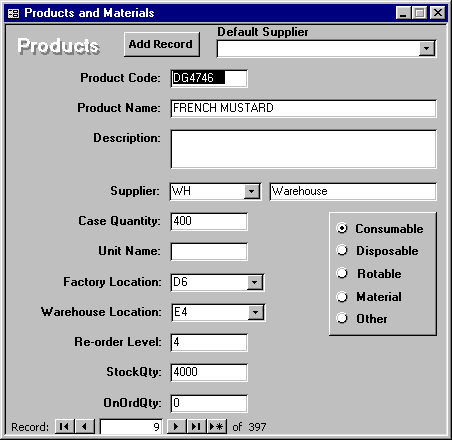David Nye Bespoke Stock Control Example
User Interface

The user interface is tailored to the organisation. The users see simple options for the primary functions they need. Rarely used administrative functions do not obscure the day to day operations. Secondary functions are normally accessed from within the forms to which they relate. This provides a very intuitive and natural interface, eliminating those frustrating hierarchical menus. However, the client may specify any other form of preferred navigation.
Stock Records

Data maintenance forms for details such as products and suppliers include the standard fields required for normal stock control operations, but are then customised and formatted to meet specific business requirements and to reflect the layout of existing forms.
Stock Enquiry
Bespoke enquiries allow your users to quickly find the information they need to do their job, using the most convenient search terms, pulling relevant data out from anywhere in the database, and performing any desired calculations.
Stock Reporting
Pre-programmed reports and management information to your specification. User defined Microsoft Access database queries and reports. Option to export to Microsoft Excel for complex analysis or to produce charts and graphs.
Automatic Batch Update

Custom software can save an enormous amount of time and dramatically reduce errors by automating any repetitive process, such as calculating stock requirements, or re-ordering to replenish stock levels and automatically generating the required purchase orders or transfer requisitions.
Bar Codes
Using bar code scanners to log stock movement in or out greatly improves accuracy and efficiency. Bar code labels can easily be printed from stock records held in the database. Click here for more bar coding details
Other Potential Features and Benefits
- Improve stock inventory management
- Check free stock on hand before purchase ordering
- Achieve target stock inventory levels
- Multiple branch or warehouse capability
- Historical sales trend reporting
- Excess stock redistribution and transfer
- Stock movement audit trails
- Automatic reorder levels

